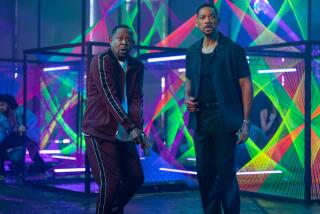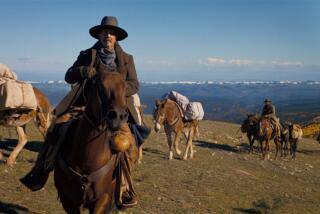Finding hope in dystopia
THE Will Smith movie “I Am Legend” takes place in 2012, three years after a botched cure for cancer wipes out the human race. Everyone, that is, except military virologist Robert Neville. When first we see Neville, he’s joy riding in a 2007 Mustang, careening through the streets of a Manhattan that has grown over itself from abandonment -- weedy, dusty and haunted.
“The minute I saw the trailer I couldn’t wait to see it,” PBS talk show host Tavis Smiley told Smith on his show airing tonight. “But I did say to myself, ‘Here come this Negro to save the world again.’ ”
But falling into cinematic racial cliche was the least of the filmmakers’ challenges. Indeed, “I Am Legend,” based on the 1954 sci-fi novella by Richard Matheson, has been something of a Hollywood hot potato for the last decade-plus; it once was in the hands of Ridley Scott, director of the dystopian classic “Blade Runner,” to star Arnold Schwarzenegger, from a script by Mark Protosevich.
It was later attached to Smith and director Michael Bay (“Armageddon”) before falling to 37-year-old Francis Lawrence, a longtime music video director who’d worked with Smith on a “Men in Black II” video.
Lawrence made his debut in features with 2005’s “Constantine,” a neo-noir, neo-goth film starring Keanu Reeves; Lawrence landed the job after lobbying to do the movie for close to a year, overcoming, he says, Reeves’ edict of no first-time directors, no video directors.
The “I Am Legend” source material was not a natural for Hollywood. Given the cataclysmic set-up -- and the dark, allegorical payoff at the end of the Matheson novel -- it is surprising to hear Lawrence say, several times, that he wanted to make a movie about hope.
“When you read the novel, I mean, it very much plays like a ‘Twilight Zone,’ which is part of what’s hard in translating it to a feature,” Lawrence, the son of a Cal State Northridge physics professor, said on a recent afternoon, promoting “I Am Legend” at the Four Seasons. “To translate it to film, if you were to do it direct, it feels more like a short. Structurally, it doesn’t have the same motor that pulls you through.”
In the novel, Neville is of English-German descent; he smokes and drinks and unwittingly falls for one of the mutant vampires, who has been sent as a spy, outside his fortified L.A. house. Matheson, a regular contributor to Rod Serling’s TV series “The Twilight Zone,” ends his story with a “Zone”-like reversal: The vampires see the human as “the other,” as fearful and mythological as they are to him. Thus the title -- and the last line of the story, said by Neville with self-reflexive bite: “I am legend.”
“I Am Legend” comes out of the gate as a Will Smith vehicle (and remains so, given that Smith is the only man on screen for much of the film, save flashbacks). After his joy ride, Neville hunts wildlife (the animals inserted digitally, which Lawrence referred to as “the wilderness pass”). Amid this strange frivolity, the character must cope with extreme social deprivation, assigning himself errands and routines to get through his day.
It is this character aspect of the story to which the film attempts to remain true, while offering the audience the reliable thrills of a Will Smith movie.
“We all had to lay out what was important to us in making the movie, and what kind of movie it was going to be,” Lawrence said of the collaboration between him, Smith and screenwriter-producer Akiva Goldsman. “And we all landed on the idea that we wanted to make a character piece. . . . We had tonal discussions, and, you know, it became very clear. . . . Will and I especially were always talking about movies like ‘The Deer Hunter’ and ‘Apocalypse Now’ and movies that were sort of told in a simpler fashion and, you know, took their time.”
“I Am Legend” was shot mostly on location in Manhattan, mostly on weekends. Lawrence said streets were blocked off at close range to evoke a sense of desolation; what wasn’t achievable from a longer view (or at all, like Central Park) was done through visual effects.
Still, there are glimpses of the city that are eerily evocative of 9/11 -- the streets devoid of people, cars coated in dust -- though Lawrence said he sought to avoid the association.
“It’s kind of too easy, a lot of movies have done it, where you take some of the things that you remember from 9/11 and apply it to a disaster movie,” he said, noting the wall of the missing in “War of the Worlds.”
Neville has gone from smoking and drinking in the book to working out and eating right on screen. (Smith’s abs, in one scene, are practically a special effect in themselves.) He doesn’t fall for a mutant, he’s locked in a kill-or-be-killed struggle with them, and in this way the movie earns its jolts in the dark.
In previous Hollywood epochs, “I Am Legend” has been adapted into “The Last Man on Earth,” starring Vincent Price, and “The Omega Man,” with Charlton Heston.
“I was thinking yesterday that the grandparent of this movie is ‘Silent Running,’ ” said screenwriter-producer Goldsman, referring to the 1972 sci-fi film starring Bruce Dern as an astronaut alone in a spaceship with the last remnants of animal and plant life.
On “I Am Legend,” Goldsman shares screenwriting credit with Protosevich, who opted not to work on the adaptation that would ultimately make it to screen, Goldsman said. The problem remained: How to take what is by today’s standards a sci-fi throwback and blow it up into a contemporary Hollywood blockbuster without blowing apart the sprit of the original.
Goldsman (“Mr. & Mrs. Smith,” “The Da Vinci Code”) is at once an admirer of those old-school sci-fi twists and dubious about translating such tales -- “O. Henry endings,” he called them -- straight to the screen.
“That tradition of that kind of reversal is great,” he said, “[but] you gotta be very careful with it. ‘The Sixth Sense’ pulled it off. It’s very hard to do in long form.”
Goldsman noted how much has changed in the genre in the time it took to remake “I Am Legend” -- zombie movies popularized, sci-fi established enough to be parodied. And yet dystopia still remains a somewhat forbidden place, or at least those that feature the kinds of endings that Matheson ventured back in the 1950s. How many movies, these days, chance to end on chilling or discomforting notes of social commentary?
While not disavowing the idea of them, “I think that truly hopeless movies, truly profoundly hopeless movies, are an exercise that I’m not interested in,” Goldsman said. “Life is difficult enough. Movies are fundamentally entertainments.”
Said Lawrence: “Sometimes I fret about it because it would be very easy to make the genre movie of this. But for me it wouldn’t be interesting because it would be empty. I’m more interested in telling that character story about hope . . . but then having all this other great stuff too as kind of the icing on top of it.”
More to Read
Only good movies
Get the Indie Focus newsletter, Mark Olsen's weekly guide to the world of cinema.
You may occasionally receive promotional content from the Los Angeles Times.










